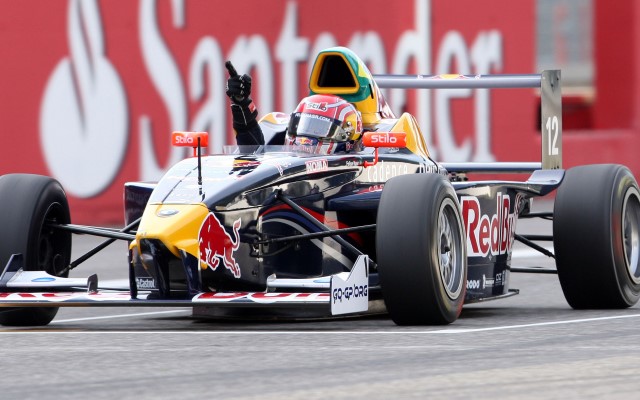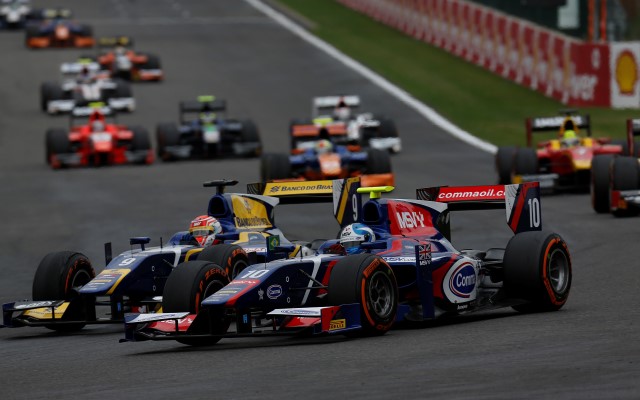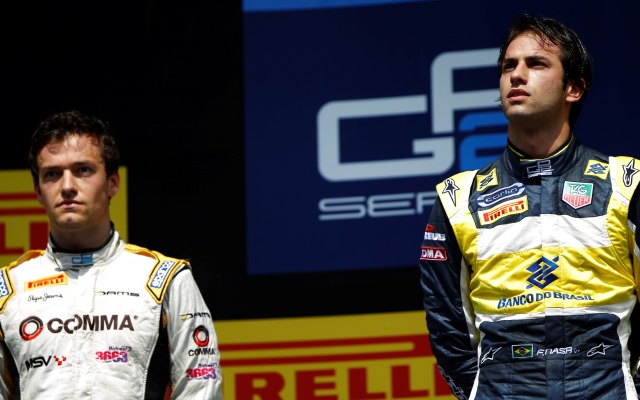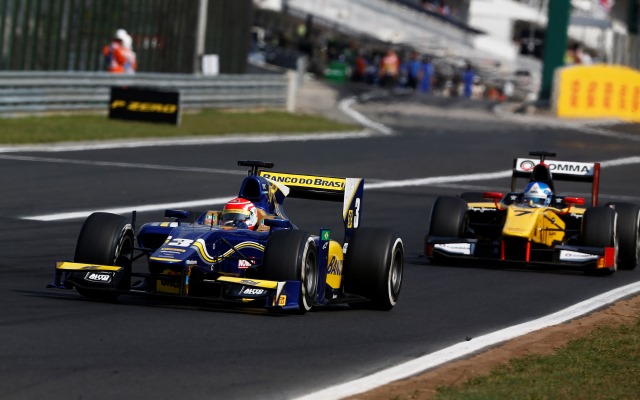The GP2 season resumes at Spa-Francorchamps this weekend following the summer break, with Jolyon Palmer taking a 43-point lead into the four-round run-in over his nearest rival Felipe Nasr.
Tensions between the pair, who were team-mates at Carlin in 2013 before Palmer switched to DAMS for the current campaign, ramped up last time out in Hungary. Nasr began the weekend with his maiden series pole and Palmer qualified off the front row for the first time all season, but the Briton would end up beating the Brazilian in both races after intense on-track fighting. A frustrated Nasr protested Palmer’s moves on the radio and after the race, but the stewards took no action.
In simple terms, it’s a classic junior single-seater battle between Britain and Brazil, calm assurance versus emotion, maturity and experience against raw talent.
How they got here
At 23, Palmer is 19 months older than Nasr, who turned 22 on Thursday. He began completing in single-seaters in 2007, in the Formula Palmer Audi series run by his father, ex-Formula 1 racer Jonathan. That followed one full year in the T-Cars tin-top junior series. In FPA, Palmer took two wins in his rookie year and finished up tenth – although he sat fifth when a serious quad biking accident ruled him out of the final five races. Staying in the series for 2008, he only won one race this time but ended up third in the standings.
At the end of 2008, Nasr made his car racing debut in the Formula BMW Americas support event at the Brazilian Grand Prix for his uncle Amir’s team, making the podium in the second of the two races behind category regulars Alexander Rossi and Daniel Juncadella. He packed his bags and headed for the European series in 2009, beating team-mate Juncadella to the title at the first attempt.
Palmer meanwhile moved onto Formula 2, which had been relaunched by his father. His first season was anonymous, with just one points finish, but his second campaign in 2010 was a vast improvement, finishing second in the standings with five wins having led for much of the way before being overhauled by rookie Dean Stoneman.

Nasr became one to watch when he took the FBMW Europe title in his first single-seater season (Photo: GEPA pictures/Mathias Kniepeiss)
Nasr had received Red Bull support in order to complete his FBMW season but turned down an offer to join their Junior Team, instead signing a management deal with David and Steve Robertson, managers of Kimi Raikkonen. That saw Nasr head to British F3 and the Raikkonen Robertson team for 2010. He finished fifth, before switching to top squad Carlin and winning the 2011 title ahead of Kevin Magnussen.
Palmer began his GP2 career in 2011, driving for the Arden team. His best result was only a ninth place, although it was a tough year for rookies with the introduction of the latest generation chassis and Pirelli tyres. His second year with iSport in 2012 brought better results, winning the Monaco sprint race (after a chassis change to eliminate a mysterious electrical issue) and going onto to take two further podiums and end the year 11th. That was one spot behind Nasr, who debuted with DAMS and scored four sprint race podiums.
For 2013, Nasr returned to the familiar surroundings of Carlin, where he was joined by Palmer. Nasr made the better start to the year, with four podiums and eight top fours from the first eight races. That put him firmly into title contention, but he would lose his consistency, failed to get his breakthrough win and added just two podiums from the last seven rounds. A lack of qualifying pace hampered Palmer early on, but another chassis change preceded his first podium of the year – victory in the feature race in Hungary.
Palmer and Nasr would clash on track next time out at Spa, when Nasr – fighting back from a disappointing qualifying – tried one aggressive overtaking move too many at La Source. Nasr would go on to be denied a win in Singapore when he was unable to defend from pole-sitter Palmer’s sheer pace. Nasr finished fourth in the standings and Palmer seventh, after a second place in Abu Dhabi.

The pair’s rivalry developed together at Carlin in 2013, famously clashing here at Spa (Photo: Alastair Staley/GP2 Media Service)
Up to now then, Nasr is certainly the one with the more impressive record – in two of his three years before GP2 he delivered a title in a competitive and respected series. And since he’s been in GP2, he’s beaten Palmer in the championship standings despite having less experience. He showed his speed and talent from he entered GP2, but struggled to really get the sort of results that he should have been able to – in particular, getting that first win under his belt.
In terms of his reputation, Palmer has suffered as a result of only competing in his father’s championships. Himself aside, few other drivers from those categories have been able to make an impact this far up the ladder, which means the competition he had isn’t that highly rated. Moreover, he failed to gather the kind of success that Nasr could in more established categories. To his credit, it seems that he has improved vastly over the length of his career so far, particularly in GP2, but unfortunately, the groundwork on a driver’s reputation is done in those early years.
Their 2014 seasons so far
Despite Palmer’s strong late season form with Carlin, he opted to switch to DAMS for 2014 – his fourth new team in as many years. At this stage, Nasr was chasing F1 opportunities, but once he had to settle with a reserve gig at Williams, he opted also to do a third season in GP2 and stick with Carlin. The two former team-mates were now the two title favourites.
Palmer enjoyed an impressive start to his campaign. In Bahrain, he claimed pole position, only finished third in the feature race but went on to win the sprint race. In Barcelona, he was twice second, and in Monaco he won the feature race from pole. This meant that he was on the podium in each of the first five races, giving him an early 44-point lead over Nasr, who was now his nearest rival after a subdued start.
Hampered by a penalty for practice contact and a poor qualifying, Nasr was only eighth in the season opener in Bahrain, and a poor start from pole restricted him to fourth in the sprint race. But he finally got his breakthrough win in Spain in the sprint race, after coming third behind Palmer in the feature. Third in the Monaco feature, Nasr then lost a couple more points to Palmer as a result of a non-finish in the sprint.

Nasr defeated Palmer to get his first win in Barcelona, but has beaten his rival just once in feature races so far this year (Photo: Sam Bloxham/GP2 Series Media Service)
Nasr closed the gap in Austria though with his first feature race win. Even though he suffered another retirement on the Sunday, Palmer had only taken a fifth and a sixth. Palmer came close to another win at home at Silverstone, but was outpaced by Mitch Evans through their pitstop phase late on. Nasr was only seventh in that race, but clinched his third win of the year in the sprint race.
Palmer was on pole again at Hockenheim but suffered a repeat of Bahrain, being beaten off the line by Stoffel Vandoorne and finishing back in third. That was still two places ahead of Nasr, who then took second in a wet-dry sprint race with Palmer sixth. Palmer’s lead was now up to 41, but Nasr reduced this with his first pole position a week later in Hungary. Palmer, meanwhile, qualified only sixth, outside of the top two for the first time this season.
He would make good progress early in the feature race though, and was soon attacking Nasr for the lead of the race. An early safety car took the fight for the win away from them and their late-stopping strategies, but Palmer passed Nasr after their stops and finished fourth, with Nasr only sixth. Palmer again caught Nasr up in the sprint race as they fought over second, and managed to get past again in a move that Nasr complained about, but which was ultimately clean. This all meant that Palmer now has a 43-point lead.
Their characteristics
Palmer’s season so far has been built upon consistency, finishing every race so far in the top seven and eight times on the podium. But he has certainly also been quick. In DAMS he has a team that knows how to set a car up for qualifying, but Palmer’s record this year shows he has made full use of this. Both consistency and speed can be put down to his experience at this level, but knowing this, Palmer has tried not to just rack up the points in the ways that Davide Valsecchi and Fabio Leimer did before, but make a positive impression in every race in order to convince people of his abilities.
He did this to devastating effect in Hungary, making aggressive and clean passes, most notably on Nasr to actually get the upper hand on his rival on track, not just on the points table. It showed he doesn’t need to qualify well to get good results. Really then, Palmer has the perfect mixture of a mature experienced approach, but also speed and overtaking prowess.

Palmer twice started behind Nasr in Hungary, but twice fought his way ahead (Photo: Sam Bloxham/GP2 Series Media Service)
But, saying that, there have been a few signs of him coming up short against some of the GP2 drivers with the most raw talent this year. There are the two occasions, in Bahrain and Hockenheim, of him being beaten off the front row of the grid by Vandoorne and failing to convert pole to victory. Evans was able to push harder and faster as they raced through pitstops late on in Silverstone. And Palmer wasn’t as comfortable as others in the wet in Hockenheim. This is nit-picking of course, given that he still collected strong points on each occasion, but it’s still relevant.
As for Nasr, getting his first win really seemed to get that monkey off his back, as two more followed in the next three weekends. He’s therefore won more often than Palmer, and with seven podiums he’s been pretty consistent too. He was unfortunate to have two non-finishes, but Palmer only gained a total of six points on him from those races anyway.
Where the main difference has been is that in six out of seven feature races so far, Nasr has finished behind his rival (Austria being the strong exception). Normally, this has been due to failing to qualify high enough up the grid, but then when he finally did get pole in Hungary, he was not strong enough in battle versus Palmer.
It’s evident therefore that Nasr, unlike his rival, is not yet the finished article when it comes to consistently getting the most out of his abilities. That talent is there – he showed it on the way to GP2 and since he’s been there – but he seems to lack the mental strength to demonstrate it every time he’s in the car. In his defence, he is at least a year behind Palmer in terms of life experience, racing experience and GP2 experience.
The future
Looking at Palmer’s form, simply maintaining his current level would seem to be enough to wrap up the GP2 title. Nasr isn’t regularly out-scoring him, and even if the Brazilian does start to do so, it will be hard to score highly enough to sufficiently eat into Palmer’s advantage.
Palmer’s consistency so far has been mostly his doing – through being able to avoid incidents on track and constantly be on-pace – but also through good luck in that he hasn’t yet had any car issues. If that were to change, and Palmer has a non-scoring weekend for example, Nasr is capable of closing quickly. Once the points gap is close, it will be wide open between them.
Looking at the circuits remaining on the calendar, Palmer has a strong record on them, with past podiums in Monza (where he was also a double winner in F2) and Abu Dhabi, although Nasr was on the podium at Spa in 2012 before his shunt with Palmer last year. Palmer had the upper hand in qualifying on Nasr at Spa, Monza and Abu Dhabi last year, but this was probably more down their relative form at the time rather than a particular knack for those circuits.
Palmer really needs to win the title to improve his chances of making it to F1. It would take a lot of money to interest teams in him if he could only finish runner-up at his fourth attempt, behind somebody less experienced. For Nasr, missing the title won’t be the end of his dreams given the long-standing reputation he has as a serious prospect, and his status as Brazil’s next hope. But winning it would make him hard to resist for some teams, and maybe even give him a chance at Williams if he ends the year more convincingly than Felipe Massa.
